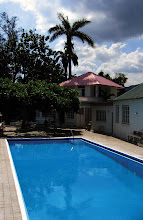It was while I was visiting Hay-on-Wye more than a decade ago that the idea of taking a tour of the mineral and volcanic springs of Jamaica first popped into my head. The inspiration was a tiny volume called The Mineral Springs of Jamaica, by the Hon J C Phillippo MD, first published for the Jamaica Exhibition of 1891.
I had plucked it from the groaning shelves of a second-hand bookshop by pure chance. As I turned the pages they began to crumble like an ancient papyrus. I decided to delay detailed perusal but not before I had absorbed that Jamaica had many different kinds of natural waters, most of them hot and all of them good for a number of different ailments - from skin conditions to rheumatism.
"To invalids shut up during the long winter of the North by gout, rheumatism, bronchitis, and consumption, "Dr Phillipo's introduction enthused, "we can not only give a mild and equitable temperature, cloudless skies and abundant occupation, but we can also give them our healing waters." I drew immediate comfort: after all, one day I might find myself shut up in the North with gout or bronchitis.
The Mineral Springs of Jamaica report is a fascinating read in every respect. First, it yields a detailed history of the discovery and development of Jamaica's natural resources in colonial times. Dr Phillippo relates how Sir Hans Sloane, the founder of the British Museum, speaks in his introduction to the History of Jamaica, published in 1707, of "a hot bath or spring near Morant, situated in a wood, which has been bathed in and drunk of late years for the belly-ache with great success."
He reveals also the aspirations of the educated landowners and their desire to have a spa town like the famous ones in Europe. "There are states and principalities in Europe that have been kept in a state of solvency by revenues derived from their springs," he says wistfully, perhaps thinking of Spa in Belgium, or Baden in Switzerland. Finally, the report embodies the Victorian obsession with measuring things and recording nerdy detail. It contains the first - and probably the only - really detailed analysis of the water from three of the island's most potent springs, complete with (favourable) comparisons with other, more famous, springs from all over the world.
But perhaps the most striking thing about Dr Phillippo's narrative is his basic sense of bemusement. Having discovered it had world-beating natural spas - and not just one sort, every sort, all packaged up in a small island paradise - Jamaica had failed to capitalise on them. At every turn, Phillippo is forced to lament the state of repair of the resources he is describing, and to stress the urgent need for funds to develop them to attract wealthy patrons from overseas. More than a century after the good doctor's report was published, I was about to experience a sense of déjà vu.
Subscribe to:
Post Comments (Atom)



No comments:
Post a Comment